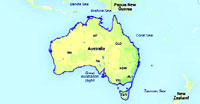
Australia has built a strong reputation for excellence and quality across its higher education. This global reputation leads a large number of international students who choose to broaden their minds and enrich their lives by pursuing higher education courses here. Every year many students from Bangladesh apply for Postgraduate (MS by Research or PhD) studies in Australia. But, lack of proper guidelines about how to apply for admission and scholarship makes it always strenuous for some students; they struggle much and thus refrain from applying. This article contains short common guidelines about how to apply for postgraduate admission, manage funding or scholarships, living cost etc.
There are numerous scholarships offered by the Australian government, universities, education institutions, and a number of other public and private organisations to support international students. The major scholarship programmes available for international students are: International Postgraduate Research Scholarship (IPRS), Australian University Scholarships, Australia Postgraduate-Research Award (APA), Endeavour Post Graduate Scholarship Award, Australia Award Scholarships (ADS/AusAID)and Supervisor funding etc. Let us look into the brief overview of the benefits from scholarships.
IPRS is funded by the Australian Government and is available to undertake post-graduate research (Masters/PhD) in Australia. It covers tuition fees and Overseas Student Health Cover (OSHC). An awardee of IPRS will be automatically awarded APA (living allowance). Endeavour award covers full tuition fees, travel allowance, an establishment allowance, living expenses and OSHC to pursue MS by research/ PhD in Australia.
AusAID scholarship is available for international students to pursue Bachelor/Masters/PhD degrees in Australian universities. The scholarship benefits include full tuition fees, return air travel, an establishment allowance, living expenses and OSHC. But the main drawback of this scholarship is only Bangladesh government employees and ICDDR individuals can apply for this scholarship and awardees are required to return in their country of citizenship for two years after degree completion.
Almost all of the Australian universities offer scholarships for international students. Unsuccessful IPRS applicants are also evaluated for university scholarships. The scholarship benefits can be different compared to the government scholarships. As the scholarship amounts differ from each other and the amount also varies from year to year, it is better to search through Google or go to the university website for more information. However, sometimes supervisor can manage funding from a research project or industrial research, which is very unusual and competitive indeed.
Let us have a look into the admission procedures. The easiest ways to apply for admission and scholarship is:
At first step, you have to manage a potential supervisor for your research. To do so, please search through university website for the list of supervisors in your field, make an excel list of them filtering by universities and send email to potential supervisors. If you can manage supervisor, then discuss with about a tentative research proposal (that you may have to prepare) and prepare required documents (contact with university admission office for this list) for application. It is recommended that you manage supervisors as many as you can to increase the possibilities, because you may get admission but not the scholarship.
Secondly, every university has deadline for scholarships. The main application round for applying scholarship round is between August and October. So, it is better to contact with supervisor within May-June. Some universities have 2 rounds of scholarship in each year. That round ranges from January-May (please check websites for more information). You need to talk with your referees long before applying for scholarship, as most of the universities need recommendation letters from at least two of your past academics.
Thirdly, after applying for scholarship and admission, you have to wait for the result, which is published between October- December depending on the scholarship deadline. Normally, it takes about 8 weeks after the deadline. Please keep in mind-you may get the admission first, then scholarship, as the result of scholarship and admission is made separately. Hence you should apply for several universities, and wait for all of the results. Get the results; choose the one that suits you the most. After getting scholarship, university will send some forms to be filled up by the applicant. If the scholarship does not cover Health Insurance, the applicant has to pay it by himself or herself (some scholarships provide health insurance for the applicant). After receiving all documents, university will issue an electronic Confirmation of Enrolment (eCoE) to the applicant. Applicant can apply for VISA then.
There are some active Facebook group like- Higher Study Abroad and Bangladeshi Students and Alumni Association in Australia where any student can get help and advice of higher study related information. The admins of this group are also pursuing higher studies abroad. All of the information is authentic and anyone can get any study related information from there. If you need more information, simply Google it or post it above-mentioned Facebook group; you will surely get answer. Best of luck with your studies!
The writer is a PhD researcher at Information Systems School, Queensland University of Technology, Australia, email:[email protected]
© 2024 - All Rights with The Financial Express
